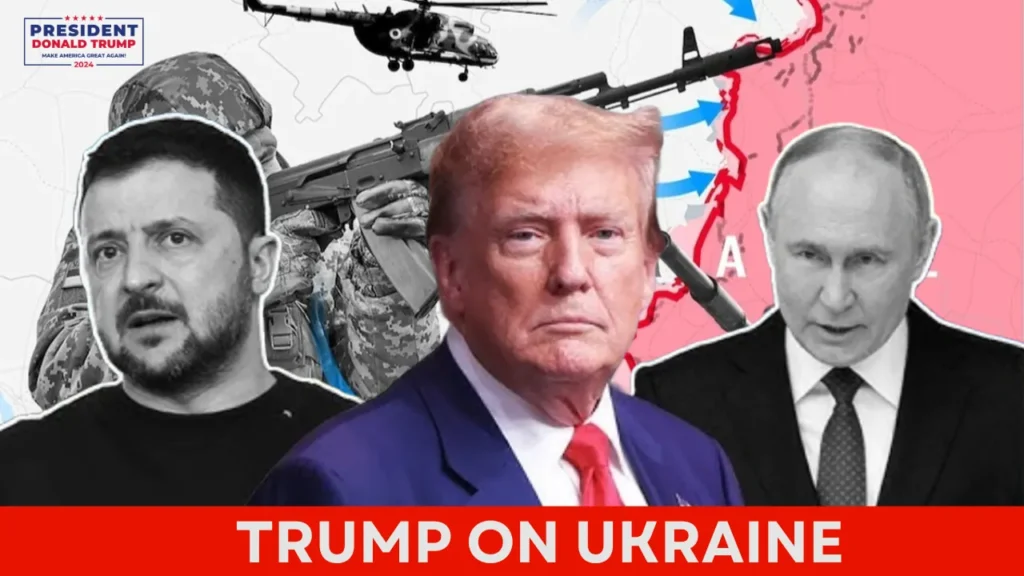Trump’s Ukraine Peace Plan: Bold Moves Amid Rising Global Tensions
The war in Ukraine, now over 1,000 days old, continues to dominate global headlines. It has reshaped international relations, tested alliances, and inflicted immense suffering on millions of civilians.
As former President Donald Trump prepares for a potential second term, his promise as Ukraine Peace Plan to end the conflict within 24 hours of taking office has generated significant attention.
While his supporters see him as a dealmaker capable of achieving peace, critics worry that his approach could support Russia and compromise Ukraine’s sovereignty. Below, I explore Trump’s Ukraine Peace Plan strategy and the latest developments shaping this high-stakes conflict.

Trump’s Ukraine Peace Plan
Trump has repeatedly pledged to bring about an immediate ceasefire in Ukraine. His Ukraine Peace Plan is built around direct negotiations with Russian President Vladimir Putin and Ukrainian President Volodymyr Zelenskyy.
According to Trump, his unique relationship with these leaders positions him as the only person who can broker a deal. He insists that his negotiation skills, honed in the business world, can resolve the conflict in a single day.
Critics, however, are skeptical of such bold claims. They argue that Trump’s approach lacks concrete details and may force Ukraine into an unfavorable settlement. A peace deal based on territorial concessions could legitimize Russia’s aggression, undermining international law. Moreover, some experts warn that quick fixes often lead to unstable agreements, increasing the risk of future conflict.
Supporters counter that Trump’s unorthodox style might be exactly what is needed. His direct communication style could break through the diplomatic stalemates that have plagued peace efforts. Whether this bold promise will translate into effective action remains to be seen, but the world is watching closely.
Shifting U.S. Foreign Policy Under Trump
Trump’s “America First” foreign policy emphasizes minimizing U.S. involvement in foreign conflicts. During his presidency, he often criticized military interventions and questioned the value of foreign aid. His potential return to office raises questions about the future of U.S. support for Ukraine, which has relied heavily on American financial and military assistance.
This shift could significantly impact NATO, the cornerstone of Western security. Trump has repeatedly called on NATO allies to increase their defense spending, accusing some members of free-riding on American support. A reduction in U.S. aid could strain NATO’s unity, potentially weakening its collective defense strategy.
Domestically, Trump’s approach resonates with a significant portion of the electorate. Many Americans support reallocating resources from foreign wars to address domestic priorities. However, this stance could polarize the political landscape further, especially as the Ukraine conflict remains a key point of international focus.
Nuclear Doctrine Updates and Rising Tensions
The conflict has brought the specter of nuclear war closer than at any point since the Cold War. Russia recently updated its nuclear doctrine, warning that continued Western military support for Ukraine could provoke a nuclear response. This development underscores the gravity of the situation and the potential global consequences of miscalculation.
Trump has yet to articulate a clear stance on nuclear deterrence in the context of Ukraine. His past comments suggest a preference for strong rhetoric to deter adversaries, but the risks of escalation remain high. Managing this delicate balance will be one of his administration’s most critical challenges if he returns to the White House.
The global community is acutely aware of these risks. Any escalation involving nuclear weapons would have catastrophic consequences, making it essential to navigate this high-stakes environment carefully. Trump’s ability to handle these tensions will be a defining test of his leadership.
Renewed Russian Missile Strikes on Civilian Infrastructure
Recent weeks have seen a resurgence of Russian missile attacks on Ukrainian cities, including Kharkiv, Dnipro, and Zaporizhzhia. These strikes have targeted critical infrastructure, causing widespread blackouts and disrupting essential services. As winter approaches, millions of Ukrainians face harsh conditions without reliable access to electricity, water, or heat.
These attacks have intensified the humanitarian crisis, prompting urgent calls for increased international aid. The strikes also highlight Russia’s strategy of targeting civilian infrastructure to weaken Ukraine’s resolve. Despite these challenges, Ukrainian forces continue to mount a resilient defense, demonstrating their determination to protect their homeland.
Biden’s Approval of Long-Range Missiles for Ukraine
President Joe Biden recently authorized the delivery of advanced long-range missile systems to Ukraine. This decision aims to bolster Ukraine’s defensive capabilities, enabling it to strike Russian military targets with greater precision. The move represents a significant escalation in U.S. military support and has drawn mixed reactions.
Trump has sharply criticized this decision, arguing that it risks prolonging the conflict. He has consistently advocated for Ukraine Peace Plan, diplomatic solutions over military interventions . His stance reflects a broader skepticism within the Republican Party regarding the Biden administration’s approach to the Ukraine war.
The provision of long-range missiles has also sparked debate among NATO allies. While some see it as a necessary step to counter Russian aggression, others fear it could escalate the conflict further. This controversy highlights the complexities of balancing military support with diplomatic efforts to achieve peace.
Zelenskyy’s Victory Plan: A Vision for Ukraine’s Future
In a recent parliamentary address, President Zelenskyy outlined a comprehensive plan to reclaim all occupied territories. His strategy includes intensified military operations and increased international support. Zelenskyy remains confident that Ukraine can achieve victory, even as the war enters a challenging phase.
The Ukrainian president’s address emphasized the importance of unity and resilience. He called on allies to maintain their support, highlighting the critical role of Western assistance in sustaining Ukraine’s defense efforts. His speech resonated with the Ukrainian public, reinforcing their determination to resist Russian aggression.
However, the path to victory is fraught with challenges. Ukraine faces significant economic and military pressures, compounded by the ongoing humanitarian crisis. How Zelenskyy’s government navigates these obstacles will be crucial in determining the war’s outcome.
Frontline Intensification: Key Battles and Counteroffensives
The battlefields in Ukraine remain highly active, with intense fighting reported in key regions such as Bakhmut and Kherson. Ukrainian forces have launched aggressive counteroffensives, aiming to disrupt Russian supply lines and regain strategic positions. These operations are critical for shifting the balance of power on the ground.
Military analysts highlight the significance of these efforts. Successful counteroffensives could strengthen Ukraine’s negotiating position in any future peace talks. However, the cost of these operations is high, with significant casualties and resource depletion on both sides.
The intensity of the conflict shows no signs of abating. Both Ukrainian and Russian forces are preparing for a prolonged struggle, with winter conditions adding another layer of complexity. The outcomes of these battles will play a pivotal role in shaping the conflict’s trajectory.
NATO’s Strategic Meeting in Brussels: Strengthening Unity
NATO leaders recently gathered in Brussels to discuss the ongoing conflict and its implications for global security. The meeting focused on enhancing military support for Ukraine and ensuring the alliance’s cohesion. This gathering highlighted NATO’s commitment to standing with Ukraine during its time of need.
Trump’s potential return to office could significantly influence NATO’s future strategy. His past criticisms of the alliance’s spending and effectiveness have raised concerns about its long-term unity. How NATO adapts to these potential changes will be crucial in maintaining a robust defense posture.
The Brussels meeting also emphasized the importance of long-term planning. As the conflict continues, NATO must balance immediate support for Ukraine with broader strategic objectives. Ensuring unity among member states will be a key challenge in the months ahead
Final Thoughts
Donald Trump’s return to the presidency could mark a turning point in the Ukraine war. His Ukraine Peace Plan offer both hope and uncertainty. Whether he can deliver on his ambitious goals will depend on his ability to navigate the complex geopolitical landscape and manage the numerous challenges ahead.
As the conflict continues to evolve, the world will closely watch Trump’s actions and their impact on global stability. The stakes could not be higher, and the path to peace remains fraught with difficulties
James Oliver
James Oliver is a seasoned political journalist, known for delivering insightful, balanced reporting on national and international politics. He simplifies complex issues, covering elections, policy reforms, and diplomacy with clarity and depth. His work emphasizes accuracy, accessibility, and truth, fostering trust and empowering readers with well-researched information.

